大学英语四六级翻译话题练习3-饮食文化
- 格式:docx
- 大小:24.11 KB
- 文档页数:5
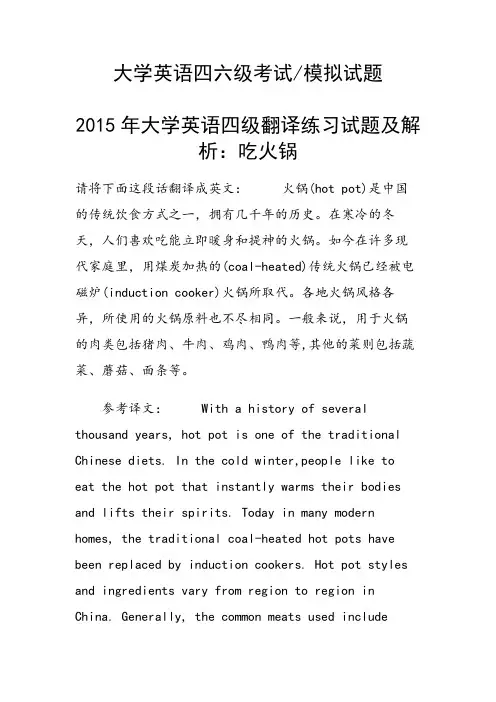
大学英语四六级考试/模拟试题2015年大学英语四级翻译练习试题及解析:吃火锅请将下面这段话翻译成英文:火锅(hot pot)是中国的传统饮食方式之一,拥有几千年的历史。
在寒冷的冬天,人们軎欢吃能立即暖身和提神的火锅。
如今在许多现代家庭里,用煤炭加热的(coal-heated)传统火锅已经被电磁炉(induction cooker)火锅所取代。
各地火锅风格各异,所使用的火锅原料也不尽相同。
一般来说,用于火锅的肉类包括猪肉、牛肉、鸡肉、鸭肉等,其他的菜则包括蔬菜、蘑菇、面条等。
参考译文:With a history of several thousand years, hot pot is one of the traditional Chinese diets. In the cold winter,people like to eat the hot pot that instantly warms their bodies and lifts their spirits. Today in many modern homes, the traditional coal-heated hot pots have been replaced by induction cookers. Hot pot styles and ingredients vary from region to region in China. Generally, the common meats used includepork, beef, chicken, duck and others, while other hot pot dishes are vegetables, mushrooms, noodles, etc.2015年大学英语四级翻译练习试题及解析:吃火锅.doc [全文共455字] 编号:6248070。
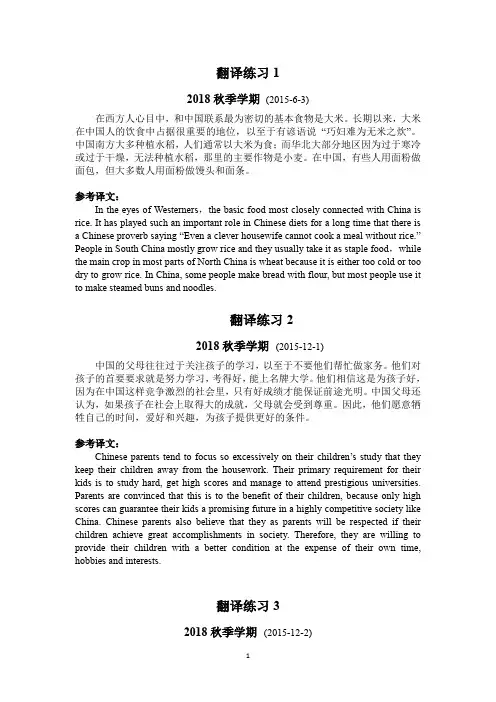
翻译练习12018秋季学期(2015-6-3)在西方人心目中,和中国联系最为密切的基本食物是大米。
长期以来,大米在中国人的饮食中占据很重要的地位,以至于有谚语说“巧妇难为无米之炊”。
中国南方大多种植水稻,人们通常以大米为食;而华北大部分地区因为过于寒冷或过于干燥,无法种植水稻,那里的主要作物是小麦。
在中国,有些人用面粉做面包,但大多数人用面粉做馒头和面条。
参考译文:In the eyes of Westerners,the basic food most closely connected with China is rice. It has played such an important role in Chinese diets for a long time that there is a Chinese proverb saying “Even a clever housewife cannot cook a meal without rice.” People in South China mostly grow rice and they usually take it as staple food,while the main crop in most parts of North China is wheat because it is either too cold or too dry to grow rice. In China, some people make bread with flour, but most people use it to make steamed buns and noodles.翻译练习22018秋季学期(2015-12-1)中国的父母往往过于关注孩子的学习,以至于不要他们帮忙做家务。
他们对孩子的首要要求就是努力学习,考得好,能上名牌大学。
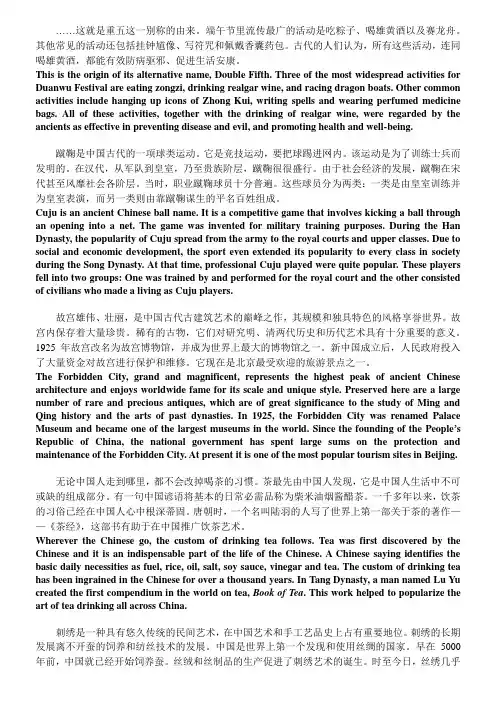
……这就是重五这一别称的由来。
端午节里流传最广的活动是吃粽子、喝雄黄酒以及赛龙舟。
其他常见的活动还包括挂钟馗像、写符咒和佩戴香囊药包。
古代的人们认为,所有这些活动,连同喝雄黄酒,都能有效防病驱邪、促进生活安康。
This is the origin of its alternative name, Double Fifth. Three of the most widespread activities for Duanwu Festival are eating zongzi, drinking realgar wine, and racing dragon boats. Other common activities include hanging up icons of Zhong Kui, writing spells and wearing perfumed medicine bags. All of these activities, together with the drinking of realgar wine, were regarded by the ancients as effective in preventing disease and evil, and promoting health and well-being.蹴鞠是中国古代的一项球类运动。
它是竞技运动,要把球踢进网内。
该运动是为了训练士兵而发明的。
在汉代,从军队到皇室,乃至贵族阶层,蹴鞠很很盛行。
由于社会经济的发展,蹴鞠在宋代甚至风靡社会各阶层。
当时,职业蹴鞠球员十分普遍。
这些球员分为两类:一类是由皇室训练并为皇室表演,而另一类则由靠蹴鞠谋生的平名百姓组成。
Cuju is an ancient Chinese ball name. It is a competitive game that involves kicking a ball through an opening into a net. The game was invented for military training purposes. During the Han Dynasty, the popularity of Cuju spread from the army to the royal courts and upper classes. Due to social and economic development, the sport even extended its popularity to every class in society during the Song Dynasty. At that time, professional Cuju played were quite popular. These players fell into two groups: One was trained by and performed for the royal court and the other consisted of civilians who made a living as Cuju players.故宫雄伟、壮丽,是中国古代古建筑艺术的巅峰之作,其规模和独具特色的风格享誉世界。
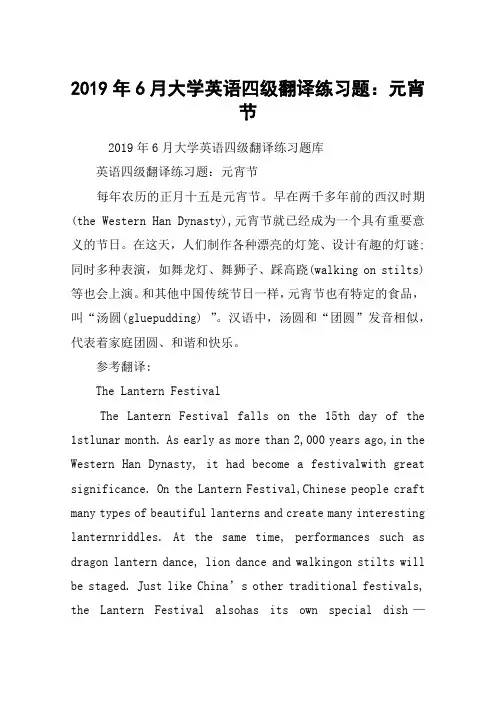
2019年6月大学英语四级翻译练习题:元宵节2019年6月大学英语四级翻译练习题库英语四级翻译练习题:元宵节每年农历的正月十五是元宵节。
早在两千多年前的西汉时期(the Western Han Dynasty),元宵节就已经成为一个具有重要意义的节日。
在这天,人们制作各种漂亮的灯笼、设计有趣的灯谜;同时多种表演,如舞龙灯、舞狮子、踩高跷(walking on stilts)等也会上演。
和其他中国传统节日一样,元宵节也有特定的食品,叫“汤圆(gluepudding) ”。
汉语中,汤圆和“团圆”发音相似,代表着家庭团圆、和谐和快乐。
参考翻译:The Lantern FestivalThe Lantern Festival falls on the 15th day of the 1stlunar month. As early as more than 2,000 years ago,in the Western Han Dynasty, it had become a festivalwith great significance. On the Lantern Festival,Chinese people craft many types of beautiful lanterns and create many interesting lanternriddles. At the same time, performances such as dragon lantern dance, lion dance and walkingon stilts will be staged. Just like China’s other traditional festivals, the Lantern Festival alsohas its own special dish—“Tangyuan, a glue pudding”. Tangyuan has a similar pronunciationwith “tuanyuan (reunion)”in Chinese, representing reunion, harmony and happiness for thefamily.1.每年农历的正月十五是元宵节:翻译时,此句要按照英语表达习惯调整成“元宵节是在每年的农历正月十五”。
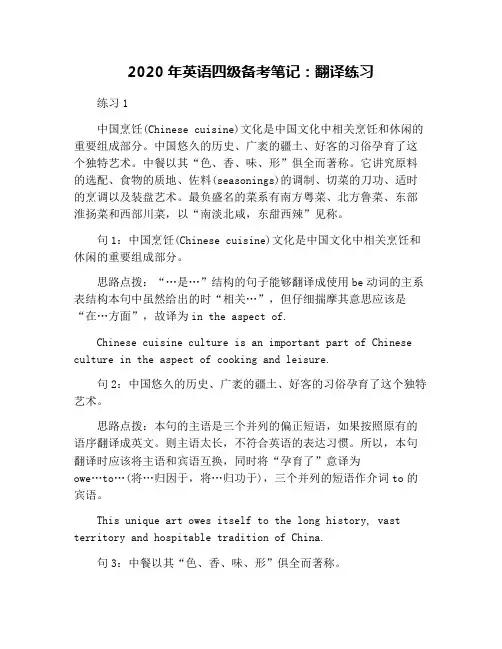
2020年英语四级备考笔记:翻译练习练习1中国烹饪(Chinese cuisine)文化是中国文化中相关烹饪和休闲的重要组成部分。
中国悠久的历史、广袤的疆土、好客的习俗孕育了这个独特艺术。
中餐以其“色、香、味、形”俱全而著称。
它讲究原料的选配、食物的质地、佐料(seasonings)的调制、切菜的刀功、适时的烹调以及装盘艺术。
最负盛名的菜系有南方粤菜、北方鲁菜、东部淮扬菜和西部川菜,以“南淡北咸,东甜西辣”见称。
句1:中国烹饪(Chinese cuisine)文化是中国文化中相关烹饪和休闲的重要组成部分。
思路点拨:“…是…”结构的句子能够翻译成使用be动词的主系表结构本句中虽然给出的时“相关…”,但仔细揣摩其意思应该是“在…方面”,故译为in the aspect of.Chinese cuisine culture is an important part of Chinese culture in the aspect of cooking and leisure.句2:中国悠久的历史、广袤的疆土、好客的习俗孕育了这个独特艺术。
思路点拨:本句的主语是三个并列的偏正短语,如果按照原有的语序翻译成英文。
则主语太长,不符合英语的表达习惯。
所以,本句翻译时应该将主语和宾语互换,同时将“孕育了”意译为owe…to…(将…归因于,将…归功于),三个并列的短语作介词to的宾语。
This unique art owes itself to the long history, vast territory and hospitable tradition of China.句3:中餐以其“色、香、味、形”俱全而著称。
思路点拨:本句中“以…而著称”用be famous for来表示;“形”不是“形状”,而是“外观”,应译为appearance; “俱全”译为perfect combination of.Chinese food is famous for its perfect combination of “color, aroma, taste and appearance”.句4:它讲究原料的选配、食物的质地、佐料(seasonings)的调制、切菜的刀功、适时的烹调以及装盘艺术。
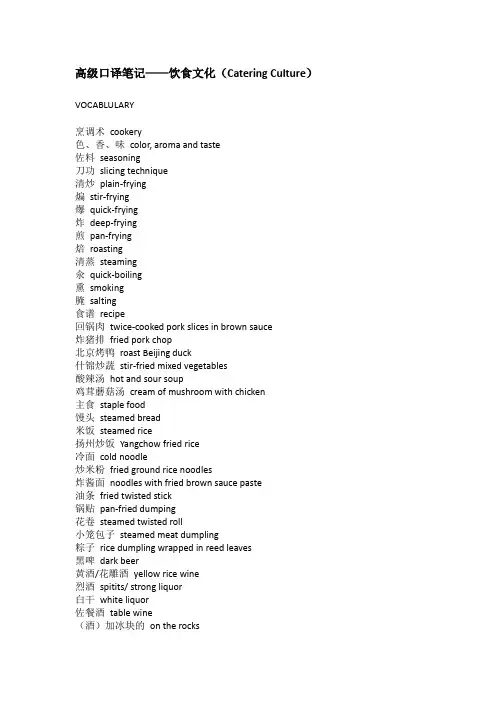
高级口译笔记——饮食文化(Catering Culture)VOCABLULARY烹调术cookery色、香、味color, aroma and taste佐料seasoning刀功slicing technique清炒plain-frying煸stir-frying爆quick-frying炸deep-frying煎pan-frying焙roasting清蒸steaming氽quick-boiling熏smoking腌salting食谱recipe回锅肉twice-cooked pork slices in brown sauce炸猪排fried pork chop北京烤鸭roast Beijing duck什锦炒蔬stir-fried mixed vegetables酸辣汤hot and sour soup鸡茸蘑菇汤cream of mushroom with chicken主食staple food馒头steamed bread米饭steamed rice扬州炒饭Yangchow fried rice冷面cold noodle炒米粉fried ground rice noodles炸酱面noodles with fried brown sauce paste油条fried twisted stick锅贴pan-fried dumping花卷steamed twisted roll小笼包子steamed meat dumpling粽子rice dumpling wrapped in reed leaves黑啤dark beer黄酒/花雕酒yellow rice wine烈酒spitits/ strong liquor白干white liquor佐餐酒table wine(酒)加冰块的on the rocks(酒)不加冰块的straight up小啜sip矿泉水mineral water红茶black tea清咖啡black coffee全脂/脱脂奶whole/skim milk酸奶yoghurt粟子chestnut马蹄梨water chestnut莲子lotus seed藕lotus root猕猴桃kiwi fruit山楂haw枣Chinese date餐前开胃点心appretizer主菜main course附菜side dish餐后甜食dessert什锦色拉mixed fruit salad with ham什锦水果圣代mixed fruit sundae民族风味餐ethnic food小吃snack冷盘cold dish点心pastry餐桌圆转盘Lazy SusanPRACTICETranslate the following passage into English评判中餐烹调的优劣可依据中餐的三大要素,即“色、香、味”。
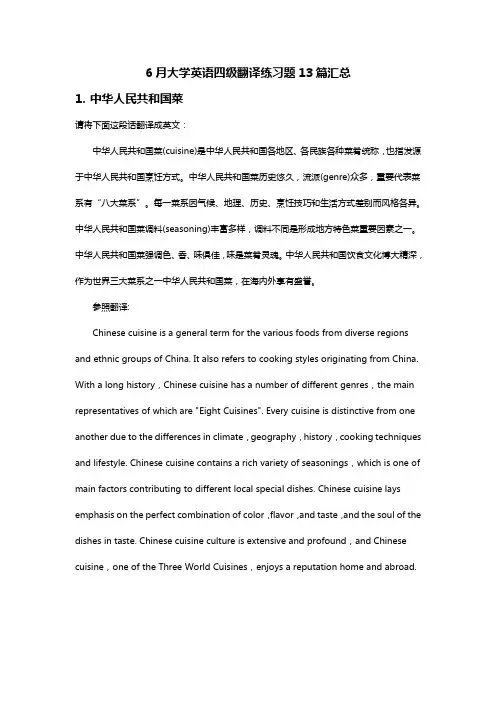
6月大学英语四级翻译练习题13篇汇总1.中华人民共和国菜请将下面这段话翻译成英文:中华人民共和国菜(cuisine)是中华人民共和国各地区、各民族各种菜肴统称,也指发源于中华人民共和国烹饪方式。
中华人民共和国菜历史悠久,流派(genre)众多,重要代表菜系有“八大菜系”。
每一菜系因气候、地理、历史、烹饪技巧和生活方式差别而风格各异。
中华人民共和国菜调料(seasoning)丰富多样,调料不同是形成地方特色菜重要因素之一。
中华人民共和国菜强调色、香、味俱佳,味是菜肴灵魂。
中华人民共和国饮食文化博大精深,作为世界三大菜系之一中华人民共和国菜,在海内外享有盛誉。
参照翻译:Chinese cuisine is a general term for the various foods from diverse regions and ethnic groups of China. It also refers to cooking styles originating from China. With a long history,Chinese cuisine has a number of different genres,the main representatives of which are "Eight Cuisines". Every cuisine is distinctive from one another due to the differences in climate,geography,history,cooking techniques and lifestyle. Chinese cuisine contains a rich variety of seasonings,which is one of main factors contributing to different local special dishes. Chinese cuisine lays emphasis on the perfect combination of color,flavor,and taste,and the soul of the dishes in taste. Chinese cuisine culture is extensive and profound,and Chinese cuisine,one of the Three World Cuisines,enjoys a reputation home and abroad.1.第一句话汉语由两个分句构成,句子较长,在译成英文时,可把它拆提成两句。
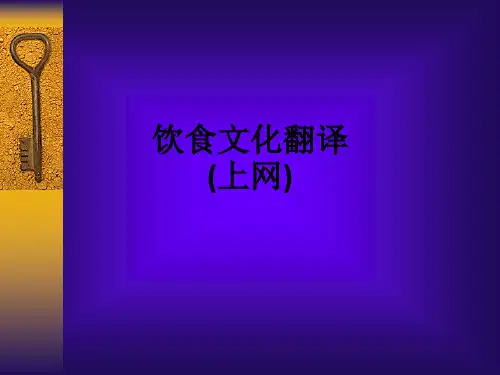
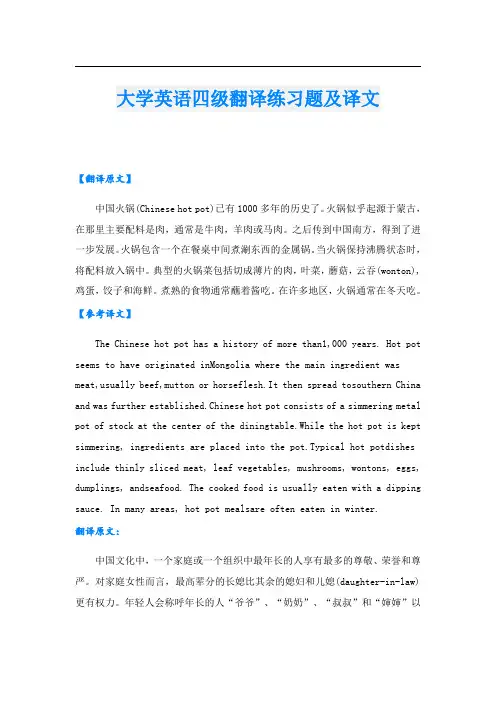
大学英语四级翻译练习题及译文【翻译原文】中国火锅(Chinese hot pot)已有1000多年的历史了。
火锅似乎起源于蒙古,在那里主要配料是肉,通常是牛肉,羊肉或马肉。
之后传到中国南方,得到了进一步发展。
火锅包含一个在餐桌中间煮涮东西的金属锅。
当火锅保持沸腾状态时,将配料放入锅中。
典型的火锅菜包括切成薄片的肉,叶菜,蘑菇,云吞(wonton),鸡蛋,饺子和海鲜。
煮熟的食物通常蘸着酱吃。
在许多地区,火锅通常在冬天吃。
【参考译文】The Chinese hot pot has a history of more than1,000 years. Hot pot seems to have originated inMongolia where the main ingredient was meat,usually beef,mutton or horseflesh.It then spread tosouthern China and was further established.Chinese hot pot consists of a simmering metal pot of stock at the center of the diningtable.While the hot pot is kept simmering, ingredients are placed into the pot.Typical hot potdishes include thinly sliced meat, leaf vegetables, mushrooms, wontons, eggs, dumplings, andseafood. The cooked food is usually eaten with a dipping sauce. In many areas, hot pot mealsare often eaten in winter.翻译原文:中国文化中,一个家庭或一个组织中最年长的人享有最多的尊敬、荣誉和尊严。

一.CET4翻译练习汇总(3)一.CET4翻译练习汇总(3)最新练习1. 八大菜系八大菜系Eight Major Cuisines 幅员辽阔 a vast territory历史悠久time-honored 多民族的multi-ethnic丰富的abundant 菜肴dish民族风俗folk customs 代表性的representative多种多样的diversified中国是一个幅员辽阔、资源丰富、历史悠久的多名族国家,每个民族都有其独特的丰富菜肴。
各个地域菜系在地理环境、气候、文化传统、民族风俗和其他因素的影响下经过悠久历史的发展已经成形。
中国最有影响力、最具代表的是鲁、川、粤、闽、苏、浙、湘、徽菜系,这八种被人们称为“八大菜系”。
中国的“八大菜系”是以多种多样的烹饪方法区分的,各有其长处。
China is a time-honored multi-ethnics nation with a vast territory and abundant resources, and every ethnic group has its unique abundant dishes. Regional cuisines have taken shape after long- history evolution under the influence of geographical environment, climate, cultural tradition, folk customs and other factors. The most influential and representative ones are Lu, Chuan, Yue, Min, Su , Zhe, Xiang and Hui Cuisines, which are commonly known as “Eight Major Cuisines ” . Dishes in the “Eight Major Cuisines” in China are characterized by diversified cooking skills with each having its strong points.2. 中国老龄化预计be expected to 猛增jump如今的current 数据figure全国老龄工作委员会China National Committee on Aging比例ratio 寿命life expectancy计划生育政策family planning policies城市家庭urban family对-----造成威胁pose threat to稳定stability根据全国老龄工作委员会的数据来看,到2053年,中国60岁及以上的老人数量预计会从目前的1.85亿一跃变为4.87亿。
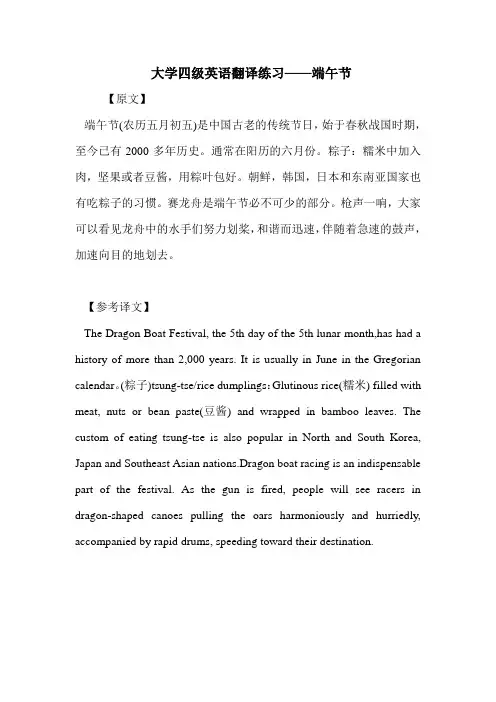
大学四级英语翻译练习——端午节【原文】端午节(农历五月初五)是中国古老的传统节日,始于春秋战国时期,至今已有2000多年历史。
通常在阳历的六月份。
粽子:糯米中加入肉,坚果或者豆酱,用粽叶包好。
朝鲜,韩国,日本和东南亚国家也有吃粽子的习惯。
赛龙舟是端午节必不可少的部分。
枪声一响,大家可以看见龙舟中的水手们努力划桨,和谐而迅速,伴随着急速的鼓声,加速向目的地划去。
【参考译文】The Dragon Boat Festival, the 5th day of the 5th lunar month,has had a history of more than 2,000 years. It is usually in June in the Gregorian calendar。
(粽子)tsung-tse/rice dumplings:Glutinous rice(糯米) filled with meat, nuts or bean paste(豆酱) and wrapped in bamboo leaves. The custom of eating tsung-tse is also popular in North and South Korea, Japan and Southeast Asian nations.Dragon boat racing is an indispensable part of the festival. As the gun is fired, people will see racers in dragon-shaped canoes pulling the oars harmoniously and hurriedly, accompanied by rapid drums, speeding toward their destination.。
题目:四级汉译英翻译:餐桌礼仪翻译原文:中国的餐桌礼仪最重要的原则是“食不言”。
吃饭不讲话被认为有益健康。
但若是参加社交的宴会(banquet),不语就失礼了。
社交宴会上的座次和上菜次序很复杂。
每上一道菜要由尊者或长着先食,他一般坐于桌首位置。
开饭后要尽量坐的靠前,以免掉落食物弄脏衣服,吃的时候尽量不要发出声响。
此外,喝汤的时候不可过快,应尽量小声。
The most important role of Chinese table manners is to remain silent while eating. Not talking over meals is supposed to be good for the health. It is impolite if people do not talk to each other during a social banquet. The table arrangements and serving order for a social banquet are extremely complicated. Each dish should be tasted by the eldest person who is seated at the head of the table. The diners should sit close to the table so food won't drop on their clothes. Try your best not to make noise when chewing. One should drink soup slowly and is not supposed to make a lot of noise.题目:六级汉译英翻译:中餐文化翻译原文:中国悠久的历史、广袤的国土、与世界各国和海外文化的广泛接触,孕育了中餐的独特艺术。
英语六级翻译练习和范文【翻译原文】我国食品种类繁多,节日食俗也丰富多彩。
春节(the SpringFestival)是我国的传统节日,人们通常从它的前夜—除夕就开始张罗了。
除夕那天,家家户户都要吃很丰盛的年夜饭。
因为“鱼”和“有余”的“余”读者相同,为了预示新年节庆有余,有些民族初一有吃鱼的习俗。
端午节(the Dragon BoatFestival)的重要食俗就是吃粽子(rice dumpling)。
粽子越做越好,品种也越做越多。
在中国,吃月饼是中秋节(the Mid-Autumn Festival)最具典型意义的食俗了。
农历八月十五这一天,人们都喜欢合家团聚,边饮酒赏月,边吃月饼。
中秋吃月饼的习俗已有悠久的历史。
【参考译文】China has a wide variety of food, and eatingcustoms on festivals are also colorful. The SpringFestival is a traditional festival in China, and peopleusually begin to bustle on New Years Eve, theevening before the Spring Festival. On that day,every family will have a hearty reunion dinner. In order to predict a surplus for the comingyear, some ethnic groups have adopted the custom of eating fish on the first day of lunarJanuary, because the sound of Chinese character for “fish” is the same with that of “surplus”.Besides, the important custom of the Dragon Boat Festival is eating rice dumplings, so ricedumplings are turning better and better and the variety of them is becoming more and morediverse. In China, eating moon cakes is the most typical custom on the Mid-Autumn Festival.On the 15th day of lunar August, people like to get together andhave a family reunion,drinking, appreciating the full moon and eating moon cakes which is a tradition of a long history.【翻译原文】当来中国的游客发现一桌标准的8人晚宴有4道凉菜、4道热菜,并配以汤和米饭时,他们往往会感到惊讶。
xx年6月英语六级翻译练习及译文中国菜(cuisine)是中国各地区、各民族各种菜肴的统称,也指发源于中国的烹饪方式。
中国菜历史悠久,流派(genre)众多,主要代表菜系有“八大菜系”。
每一菜系因气候、地理、历史、烹饪技巧和生活方式的差异而风格各异。
中国菜的调料(seasoning)丰富多样,调料的不同是形成地方特色菜的主要原因之一。
中国菜强调色、香、味俱佳,味是菜肴的灵魂。
中国饮食文化博大精深,作为世界三大菜系之一的中国菜,在海内外享有盛誉。
Chinese cuisine is a general term for the variousfoods from diverse regions and ethnic groups of China. It also refers to cooking styles originating from China. With a long history, Chinese cuisine has anumber of different genres, the main representativesof which are "Eight Cuisines". Every cuisine is distinctive from one another due to thedifferences in climate,geography, history, cooking techniques and lifestyle. Chinese cuisinecontains a rich variety of seasonings, which is one of main factors contributing to differentlocal special dishes. Chinese cuisine lays emphasis on the perfect bination ofcolor, flavor, and taste,and the soul of the dishes in taste. Chinese cuisine culture is extensiveand profound,and Chinese cuisine, one of the Three World Cuisines,enjoys a reputation homeand abroad.1.第一句话的汉语由两个分句组成,较长,在译成英文时,可把它拆分成两句。
Translation
【话题5/6】传统文化类:饮食文化(Culinary Culture)
I. Chinese Food
(1) The Features of Chinese Food
color, aroma, taste(色、香、味)
cooking methods:
boil(煮);stew(煲/炖);fry(煎);stir-fry(炒);deep-fry(炸);smoke(熏);roast/barbecue(烤);bake(烘);steam(蒸)seasonings(调味品):
salt(盐)-salty(咸的);
sugar(糖)/honey(蜂蜜)-sweet(甜的);
vinegar(醋)-sour(酸的);
ginger(姜)/scallion(葱)/chili(辣椒)-pungent/spicy(辣的);sesame oil(芝麻油)/coriander(香菜)/wine(酒)-fragrant(香的);bitter(苦的);garlic(大蒜)
(2) Tableware(餐具)
chopsticks(筷子);spoon(勺子);bowl(碗);plate(盘);dish(碟)(3) Eight Regional Cuisines(八大菜系)
China is a vast country with diverse climates, customs, products and habits. Favored dishes vary from region to region.
in coastal areas(沿海地区)——seafood(海鲜);aquatic products(水产品)in central and northwest China——domestic animals(家畜);poultry(家禽)Sichuan Cuisine(川菜):
hot pot(火锅);mar-boh tofu(麻婆豆腐)
Guangdong Cuisine(粤菜):
porridge(粥);refreshment(点心)
Jiangsu Cuisine(苏菜);Zhejiang Cuisine(浙菜);Hunan Cuisine(湘菜);Anhui Cuisine(徽菜);Fujian Cuisine(闽菜);Shandong Cuisine(鲁菜)
II. Chinese Tea
green tea(绿茶);black tea(红茶);oolong tea(乌龙茶);teapot(茶壶);brew tea(泡茶);pour tea(冲茶);offer tea(敬茶);taste tea(品茶);take a sip(抿一口)
III. Chinese Wine
be used as sacrificial offerings to Heaven, Earth of ancestors
(被用于对天、地、神的祭祀)
(1) Wine Feasts(酒会、酒宴)
wedding banquet(婚宴)——arm-crossed wine(交杯酒)
month-old wine feasts(满月宴);hundredth-day wine feasts(百日宴)longevity wine feasts(长寿宴);elders(老人)
(2) Drinkers’ Wager Game(酒令)
createmore cheerful atmosphere while drinking
urge drinkers to drink more
tell jokes(讲笑话);solve riddles(猜谜);chess(下棋);
pass down a flower to the beats of a drum(击鼓传花)
compose poems(作诗);solve word puzzles(猜字谜)
shoot an arrow(射箭);pitch an arrow(投壶);throw a dice(掷骰子)
Directions: For this part, you are allowed 30 minutes to translate a passage from Chinese into English.
腊八节通常在1月中旬,农历腊月初八,标志着春节庆祝活动的开始。
大多数汉族人遵循腊八节喝腊八粥的习俗。
腊八粥最早在宋朝传入中国。
据史料记载,一些大型寺庙会为穷人提供腊八粥来表达对佛祖(Buddha)的虔诚。
明朝时,腊八粥成为皇帝在过节时赏赐群臣的神圣食物。
Translation-Passage6
Directions: For this part, you are allowed 30 minutes to translate a passage from Chinese into English.
当今社会,客来敬茶已经成为人们日常社交和家庭生活的普遍礼仪。
上茶时应以右手端茶,从客人的右方奉茶,并时带微笑。
当然,喝茶的客人要以礼还礼,双手接过,点头致谢。
品茶时,讲究小口品饮,其妙趣在于意会而不可言传。
总之,敬茶不仅是对客人和朋友的尊重,而且能体现自己的修养。
Directions: For this part, you are allowed 30 minutes to translate a passage from Chinese into English.
腊八节通常在11月中旬2,农历腊月初八,标志着春节庆祝活动的开始。
Laba Festival usually falls1 on the 8th day of the last lunar month, in mid-January2, marking the beginning of celebrating the Chinese Spring Festival.
大多数汉族人遵循腊八节喝腊八粥的习俗。
The majority of the Han people has followed the tradition of eating Laba porridge in Laba Festival.
腊八粥最早在宋朝传入1中国。
Laba porridge was first introduced to1China in the Song Dynasty.
据史料记载1,一些大型寺庙会为穷人提供腊八粥来表达对佛祖的虔诚2。
According to historical records1, some large temples would offer Laba porridge to the poor to show their faith2 to Buddha.
明朝时,腊八粥成为皇帝在过节时赏赐群臣1的神圣食物。
During the Ming Dynasty, Laba porridge became a holy food that emperors would use to award their officials1 when spending the festival.
Directions: For this part, you are allowed 30 minutes to translate a passage from Chinese into English.
当今社会,客来敬茶1已经成为人们日常社交和家庭生活的普遍礼仪2。
Nowadays,offering tea to guests1has become common etiquette2in daily social interaction and family life.
上茶时应以右手端茶,从客人的右方奉茶,并时带微笑。
Tea cup should beheld on the right hand and offered to guests with a smile from their right side.
当然,喝茶的客人要以礼还礼1,双手接过,点头致谢。
Of course, the guests should pay respect as well1, taking over the tea cup with both hands and nodding to express their thanks.
品茶时,讲究小口品饮1,其妙趣在于意会而不可言传2。
When tasting tea, we should drink it in small sips1, the beauty and fun of which are beyond words2.
总之,敬茶不仅是对客人和朋友的尊重,而且能体现自己的修养。
In short, offering tea can not only show respect to guests and friends, but also reflect one’s self-cultivation.。